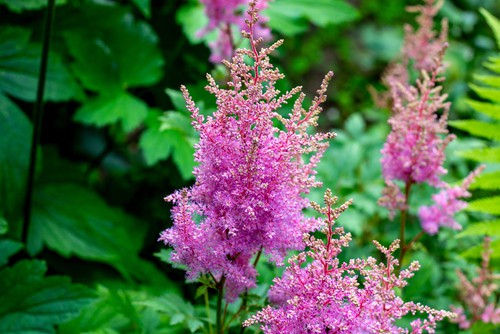Last updated on April 28th, 2022
Our site is reader supported, this means we may earn a small commission from Amazon and other affiliates when you buy through links on our site.
If you are going to divide an existing parent plant, you can do it very easily at multiple points throughout the year. You have the option of taking your divisions and transplanting them immediately, or hanging onto them and transplanting them at a later date.
When should you divide Astilbes?
You can successfully divide your Astilbe in the autumn or at the beginning of spring. As is the case with most perennials the latter is probably preferred because they are starting to root and they come back to life after being dormant over winter.
Dividing Astilbes in spring
If you are planning to divide your Astilbes in the spring, you (ideally) want to do so in the early spring. You should do this when the plants are still in their dormancy. The reason for this is that you want to give each of your divisions adequate time to become established throughout the season.
Dividing Astilbes in autumn
If you are planning to divide your Astilbes in the autumn, each of the divisions you take from the parent plant should be stored temporarily in potting compost, in containers, and moved somewhere dark and cool (like your garage) during the winter, which is why we prefer to do it in spring where possible.
They can then be planted in their permanent location in the early spring. It is always best to wait and divide the rhizomes after your parent plant has finished flowering.
How to divide and split established Astilbes

If you are dividing your Astilbe and then planting, make sure you have an area in mind ready before you start the division process so that your divided plants can be transplanted immediately. If you are dividing your Astilbes in the autumn all you need is some empty pots and some compost to keep them in over winter.
- The first step is to water the area around the Astilbe you’re going to divide. You want to water it thoroughly and let the water settle so that the soil is much looser. This will make it easier when you remove the plant for the division.
- Make sure that you have a new position if you’re going to transplant your divisions immediately, and have the holes dug ahead of time. These holes should be around 20cm deep and between 30cm and 45cm apart. If you are going to improve your soil by adding compost, dig the hole a little deeper so that you have room to mix it in.
- Take the parent plant and remove any debris from around it, and the plant material on top by cutting it away so you are just left with the root system at ground level. Then measure a diameter of approximately 20cm-30cm around the plant, from the base and mark it somehow. This is where you’re going to start the digging when you divide your plant.
- Using a spade, dig the plant out keeping to the diameter mark and digging out into the shape of a large bowl. The idea is to keep a lot of soil intact so you don’t damage any of the roots when you remove the main plant from the ground. The less damage you can do to the parent plant, the more divisions you will have and the faster the parent plant will recover.
- Hold the Astilbe root system and look for the “eyes” on the rhizomes. The eyes are where small shoots come out of the rhizome. Pinch off sections of the roots with 3-5 eyes. Single established Astilbes should give you, on average, four or five divisions.
- Place your fresh transplants into their holes with the eyes facing upwards, or place them in a container for storage over winter if you are doing this process in the autumn. If you transplant them immediately make sure you water them thoroughly and if you transplant them at the beginning of spring, give the divisions some fertiliser, such as bone meal or growmore to give them a boost.
Top Tips:
If you take your divisions in autumn and store the new plants, put them in a container with well-draining potting soil. We recommend using multipurpose compost with some grit mixed in and leaving the container somewhere dark, like your shed or your garage.
During the winter they don’t need a lot of water or any food. You also don’t want to leave them completely dry out because the roots can dry up. Check how moist the soil is and watering the containers every 2 or 3 weeks should be enough to get them through until spring.


